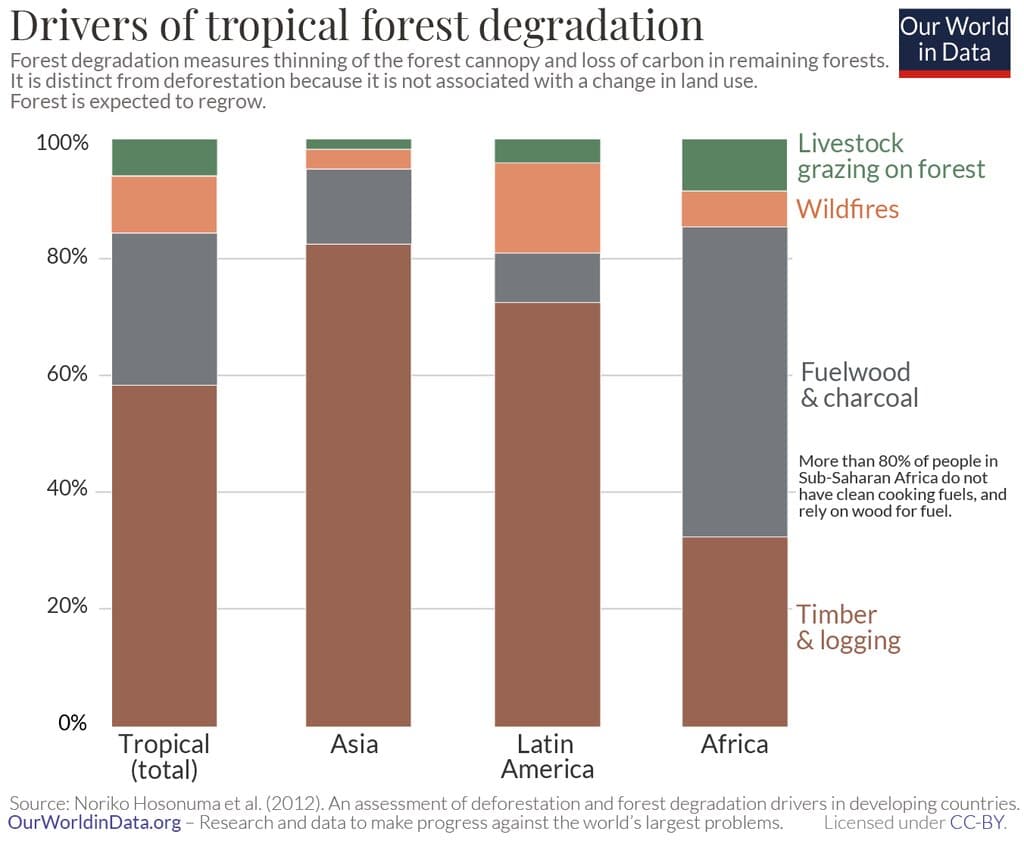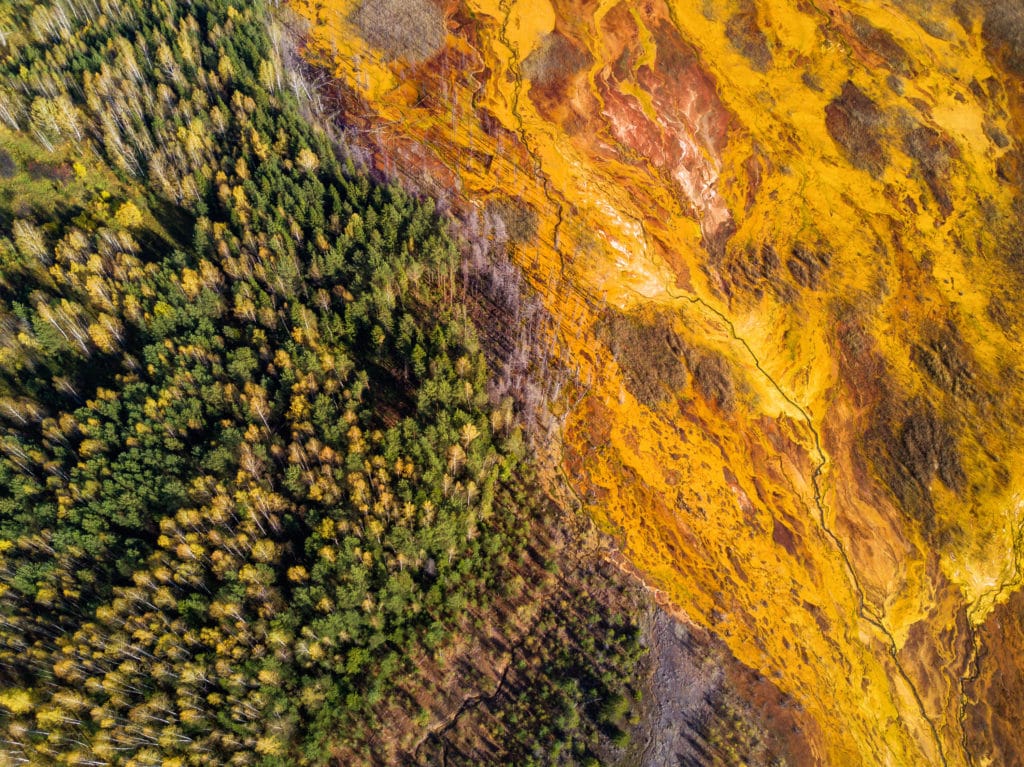Through land clearing for agricultural farming, logging for products such as timber and paper, urban expansion, and infrastructural development, humans are destroying one of Earth’s most important natural resources: forests. Even if the rate at which we cut down trees is slowly but steadily decreasing, we are still losing a staggering 10 million hectares of forests every year. Here are 10 shocking statistics about deforestation that will make you understand its devastating impact on our precious planet.
—
1. We lose approximately 10 Million Hectares A Year
We are getting better, but it doesn’t mean we are doing enough. Since 1990, deforestation has robbed the world of approximately 420 million hectares. Despite the rate at which we cut down trees has been slowly decreasing in recent years, we still lose approximately 10 million hectares of forests each year and no continent in the world is spared. The most affected ones are Africa – with major forest loss occurring in the Democratic Republic of the Congo, Angola, and Tanzania – and South America. In the latter, Brazil and Paraguay are by far the most impacted countries. However, some Southeast Asian regions like Indonesia, Cambodia, and Myanmar have also lost staggering amounts of forests over the last 10 years.
2. We Are Losing Forests at a Rate Equivalent to 27 Soccer Fields per Minute
The world was once a much greener place. 10,000 years ago, 71% of the Earth’s land surface – a total of 10.6 billion hectares – was covered by forests, shrubs, and wild grasslands. Today, half of this land is mostly used for agriculture, grazing, and urban settlements, while the total surface still covered by forests and grassland dropped down to just around 4.1 billion hectares. To put things into perspective, we are losing forests at a rate equivalent to 27 soccer fields per minute.
3. 95% of Deforestation Happens in the Tropics
59% occurs in Latin America, 28% in Southeast Asia, and it happens in most part because of rich nations. Indeed, trees here are cut down first and foremost to satisfy the needs of developed countries, which import products that are produced on a large scale on deforested land, such as beef, vegetable oils, cocoa, coffee, and paper. Russia, China, India, and the US are among the countries contributing the highest rates of deforestation abroad.
4. 99% of Haiti’s Native Forests Have Been Cut Down
Haiti is among the most deforested countries in the world. Trees have been cut down to make space for coffee, tobacco, and sugarcane plantations as well as to extract charcoal, the country’s primary source of domestic energy. To date, fewer than 40,000 hectares remain, but experts estimate that in the next 20 years, Haiti’s rainforest may be lost completely, making the country one step closer to losing most of its rich biodiversity, a study from Temple University found. Haiti has nearly 500 known species of amphibians, mammals, and reptiles. Of these, 16.2% are endemic – meaning they only exist in this country – and 15.6% are threatened.
You might also like: The Importance of Local Communities in Fighting Deforestation in Haiti: An Interview With Caitlyn Eberle
5. 75% of Tropical Rainforests Have Lost Resilience
It might be too late to save the Amazon rainforest. Indeed, almost 75% of tropical rainforests have lost resilience, meaning they no longer have the ability to recover from events such as major wildfires and droughts. Experts believe that the Amazon rainforest could soon reach a point of no return which would trigger dieback and turn much of the forest – one of Earth’s richest regions in terms of biology – into savanna. Along with precious trees, the world would lose nearly 25% of global biodiversity as well as one of its most crucial carbon sinks, which keeps nearly 400 billion tons of carbon dioxide out of the atmosphere.
6. Between 2017 and 2015, Tropical Forests Released 10 Billion Tonnes of Carbon Dioxide
Deforestation is turning carbon sinks into a carbon source. 15 billion trees are cut down every year. Apart from destroying ecosystems and triggering biodiversity loss, deforestation accelerates global warming. As some of the world’s largest carbon sinks, forests play a huge role in absorbing planet-warming carbon dioxide from the atmosphere. When trees are cut down, the carbon they store is released back into the atmosphere, mainly as carbon dioxide. Between 2015 and 2017, the global loss of tropical forests generated 10 billion tonnes of carbon dioxide – nearly 10% of the annual human CO2 emissions.
You might also like: 12 Major Companies Responsible for Deforestation
7. Nearly 1.6 Billion Hectares of Forest Are at High Risk of Degradation
In terms of land mass, forest degradation is an even bigger problem than deforestation. Nearly 1.6 billion hectares of forest are at high risk of degradation in the next decade. This phenomenon occurs when forest ecosystems are weakened to a point where they lose their ability to provide goods and services to people and nature. Even though climate change is a contributing factor in degradation, the main trigger for it has been unsustainable and illegal logging. This, along with timber extraction, are the major drivers in Asia and Latin America: together, they account for more than 70% of total tropical forest degradation. In Africa, this occurs as forests are exploited to obtain fuelwood and charcoal. Indeed, more than 80% of people in Sub-Saharan Africa do not have clean cooking fuels and thus heavily rely on wood.

Figure 2: Drivers of Tropical Forest Degradation
8. Due to Forest Conversion, Luxembourg’s Emissions Reached 2.8 Tonnes per Year, the Highest in the World
Between 2010 and 2014, Luxembourg had the highest per capita CO2 emissions linked to deforestation for food production with nearly 2.8 tonnes per year, closely followed by Brazil. In the same period, the average Brazilian generated 2.7 tonnes of CO2 per person from domestic and imported food, mainly beef. This example helps explain why we talk about a vicious cycle when it comes to deforestation: cutting down trees at the rate we are used to is driving climate change, which in turn hurts the food production of existing farmland. This pushes governments to convert even more forests into agricultural land in order to meet the ever-increasing demand of consumers, especially from developed countries.
9. 25% of Western Drugs Used to Treat Diseases Come From the Rainforest
Global forests hold treasured for curing multiple diseases. 25% of Western drugs used to treat diseases such as bronchitis, rheumatism, diabetes, and tuberculosis, as well as nearly one in four cancer-fighting drugs, come from the rainforest. And yet, pharmaceutical companies have only scratched the surface. It is estimated that, to date, less than 1% of all rainforest plants have been tested for their medical properties. However, deforestation is preventing scientists from looking for potential plants and trees with medical properties and will make research increasingly difficult to carry out. In order to slow down the rate of deforestation and prevent this scenario from turning into reality, pharmaceutical companies worldwide are responding to this threat by signing international treaties such as the Convention on Biological Diversity. One of this treaty’s components, the Nagoya Protocol, regulates fair and equitable practices for extracting and using natural resources, thereby promoting the creation and readjustment of protected areas and the conservation of biodiversity.
10. Over One Million Indigenous People as Well as Thousands of Animal and Plant Species are Threatened by Deforestation
Biodiversity on Earth is at risk. 250 million people live in forests and nearly 2 billion people directly depend on them for their livelihoods. The Amazon rainforest alone is home to over one million Indigenous people. Divided into more than 400 tribes, they live by the rules of nature. However, Indigenous tribes are becoming increasingly vulnerable to deforestation, which has forced many people to migrate to urban areas and change their lifestyles completely. Forests are also home to more than 80% of the world’s life on land. However, the world is losing 137 species of plants, animals, and insects every day to deforestation and a staggering 50,000 species become extinct each year. Currently, the orangutan, the Sumatran rhinos, and chimpanzees account for the most critically endangered species on Earth.
Featured Image: Courtesy of Vasily Iakovlev
You might also like: 10 Amazon Rainforest Deforestation Facts to Know About


















